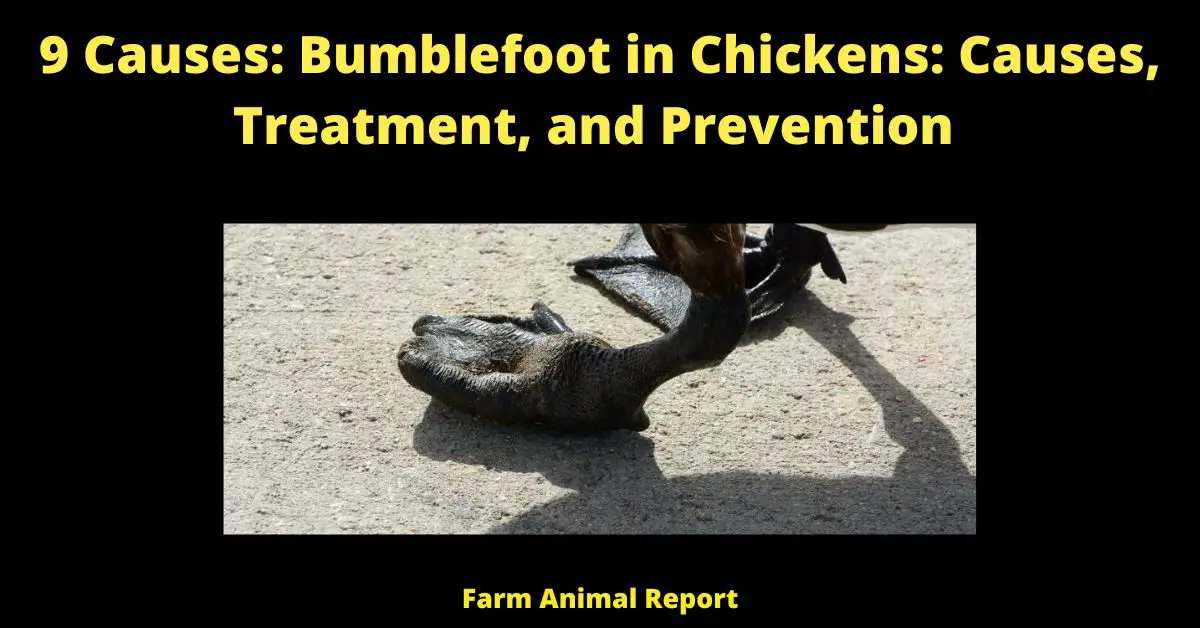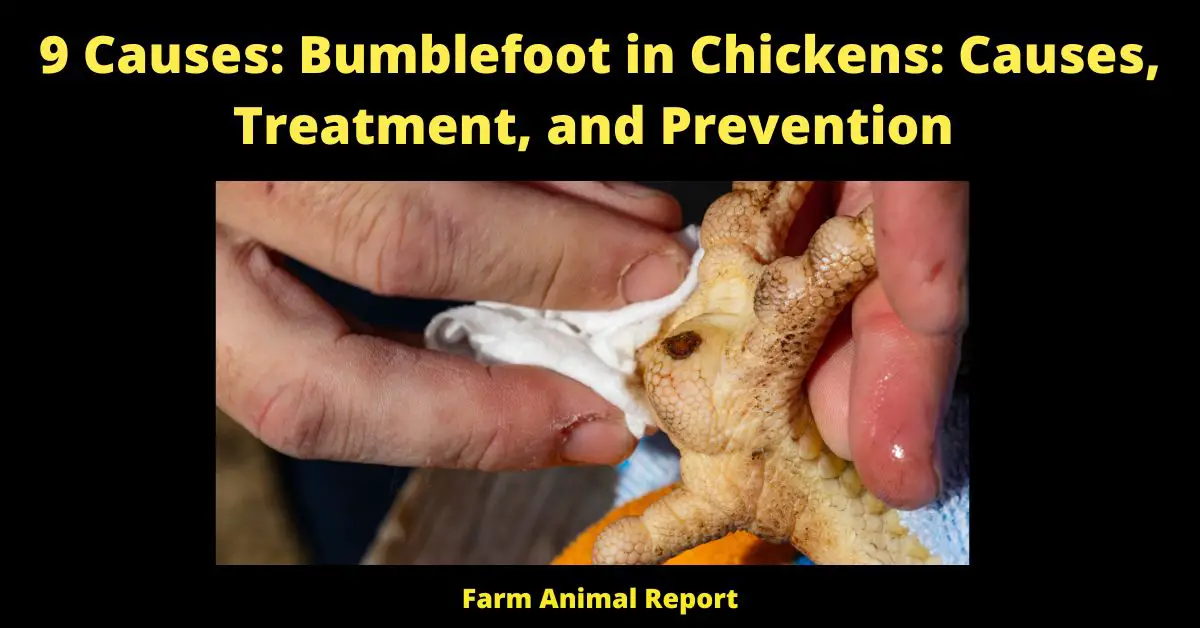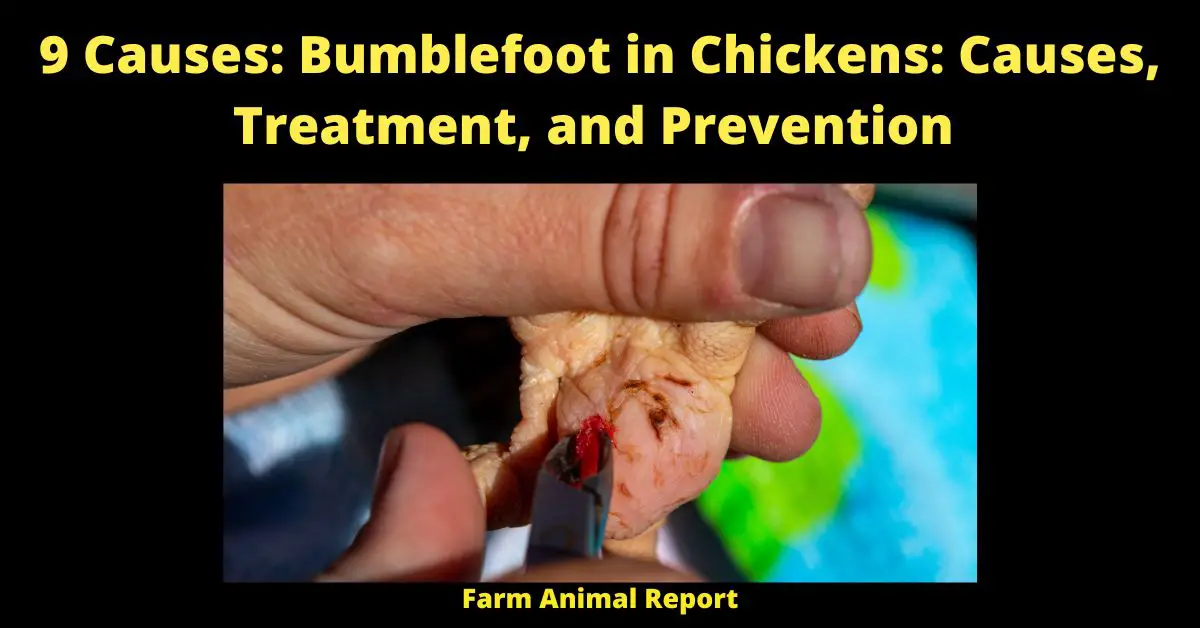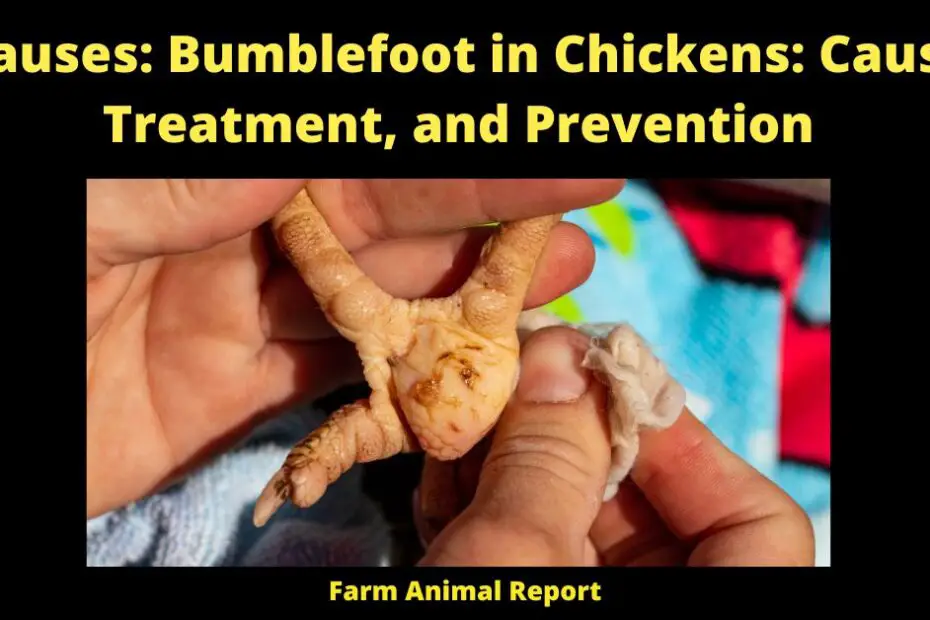Do you have a chicken with a bumblefoot infection? If so, you’re not alone. Bumblefoot is a common ailment in chickens that can cause serious problems if not treated. In this blog post, we will discuss what causes bumblefoot, how to treat it, and how to prevent it from happening in the first place.
What is Bumblefoot in Chickens?
Bumblefoot in chickens is a condition that can occur when bacteria enter through a Chicken’s foot, usually at the bottom of the foot, chicken’s footpad, and multiplies. The resulting infection can cause the footpad to swell, become painful, and eventually burst.
In severe cases, the infection can spread to the chicken’s bones and joints, causing permanent damage. Bumblefoot is most commonly caused by dirty or wet conditions, overcrowding, or injury to the footpad. However, any condition that weakens the immune system can also increase the risk of developing bumblefoot.

Treatment typically involves antibiotics and/or surgery to remove the infected tissue. In some cases, amputation of the affected foot may be necessary. With prompt treatment, most chickens recover from bumblefoot without any long-term effects. However, if left untreated, the condition can be fatal.
What is Plantar Pododermatitis in Chickens?
Pododermatitis, or podiatry, is an inflammatory condition of the footpad and underlying tissue in chickens. It is a very common disease in backyard flocks and can affect any age chicken. The footpad is the firm, rubbery, cushiony part of the chicken’s foot that you see when they walk.
It acts as a shock absorber and helps insulate the feet from cold temperatures. Pododermatitis can be caused by many different things, but the most common cause is bacteria. Bacteria can enter through small cuts or scrapes on the footpad or through the pores in the skin. Once the bacteria are inside, they multiply and cause an infection.
See Amazons Educational Resources for Chicken Diseases
The infection causes swelling, redness, and pain in the footpad. In severe cases, the infection can spread to the bone and joints, causing lameness. Pododermatitis is a serious disease that can lead to death if left untreated.
If you think your chicken has pododermatitis, take them to a veterinarian for treatment. There are many different ways to treat pododermatitis, so it is important to get your chicken evaluated by a professional. Early diagnosis and treatment are essential for a successful outcome.

What is Staphylococcus Aureus in Chickens? (Removal)
Staphylococcus aureus is a bacteria that can cause disease in chickens. The bacteria can infect the skin, respiratory tract, and reproductive organs of chickens. Symptoms of infection include lethargy, decreased appetite, and increased thirst. Infected birds may also have ruffled feathers and swollen joints. In severe cases, staphylococcus aureus can cause death. (Escherichia coli), (e. coli)
The bacteria are typically spread through contact with contaminated surfaces or water. They can also be spread through contact with infected birds. To prevent the spread of staphylococcus aureus, farmers should practice good biosecurity measures, such as cleaning and disinfecting chicken coops regularly.
Birds that are infected with the bacteria should be isolated from healthy birds to prevent the spread of infection. Treatment of staphylococcus aureus infection typically includes antibiotics. Farmers should consult with their veterinarian to determine the best course of treatment for their chickens.
What is Ulcerative Pododermatitis for a backyard chicken keeper?
Ulcerative Pododermatitis (also called bumblefoot) (sore hocks) is a common disease that affects backyard chickens. The condition is caused by a bacterial infection that enters the chicken’s foot through a cut or scrape.
Once the bacteria get inside the foot, it multiplies and causes inflammation of the tissue. The affected foot will often become swollen, red, and painful. If left untreated, Ulcerative Pododermatitis can lead to tissue death and even amputation of the foot. Fortunately, the condition is easily treated with antibiotics
Ulcerative pododermatitis is a condition that affects the feet of chickens. The symptoms include raised, red lesions on the legs and feet, and the feathers around the lesions may be lost. Ulcerative pododermatitis can be caused by a number of different factors, including bacteria, fungal infection, trauma, or vitamin A deficiency.
In most cases, ulcerative pododermatitis can be treated with antibiotics or antifungals. Prevention is the best treatment, however, and good foot hygiene is essential for preventing the condition. Backyard chicken keepers should inspect their birds’ feet regularly and take steps to keep them clean and dry. Any birds showing signs of ulcerative pododermatitis should be isolated from the rest of the flock and treated by a veterinarian.

What Causes Bumblefoot in Chickens?
Bumblefoot in chickens is caused by a bacterial infection that enters through a chicken’s footpad. The resulting infection can cause the footpad to swell, become painful, and eventually burst. In severe cases, the infection can spread to the chicken’s bones and joints, causing permanent damage.
Bumblefoot is most commonly caused by dirty or wet conditions, overcrowding, or injury to the footpad. However, any condition that weakens the immune system can also increase the risk of developing bumblefoot. Treatment typically involves antibiotics and/or surgery to remove the infected tissue.
In some cases, amputation of the affected foot may be necessary. With prompt treatment, most chickens recover from bumblefoot without any long-term effects. However, if left untreated, the condition can be fatal.
Common Causes of Bumblefoot
- Open wound
- small cuts at bottom of foot
- Sharp Objects
- Can Spread to Rest of Flock
- Obese Chickens
- Splintered Roost
- Minor Cuts
- Forms Black Scab, Brown Scab
- An abundance of Fecal Matter
- Pododermatitis foot pad
- Foot pad dermatitis
- Foot deformities chickens
You can Prevent Bumblefoot in your Chicken Flock by taking some simple precautions:
- Keep your coop clean and dry to prevent bacteria from entering through the footpads
- Inspect your chickens’ feet for early Stages, and regularly for any cuts or scrapes that could become infected
- Provide plenty of space so that chickens are not overcrowded and do not have to walk on sharp or rough surfaces
- Keep your chickens’ immune system strong by feeding them a nutritious diet and providing access to fresh water and vitamin supplements.
If you think one of your chickens has bumblefoot, consult an avian veterinarians as soon as possible. Early diagnosis and treatment are essential for a successful recovery.
What are the Symptoms of Bumblefoot in Chickens?
The most common symptom of bumblefoot in chickens is swelling and redness of the footpad. The footpad may also be warm to the touch and painful when pressure is applied. In severe cases, the infection can spread to the chicken’s bones and joints, causing permanent damage. If you think one of your chickens has bumblefoot, consult a veterinarian as soon as possible. Early diagnosis and treatment are essential for a successful recovery.
- Cuts
- Limping
- Cripple
- Inflammation
- Black Scab
- Brown Scab
- Major Infection
- Minor infection
- Pus
What are Some Treatment options for Bumblefoot in Chickens? ( Treat Bumblefoot)
Best way treatment typically involves antibiotics and/or surgery to remove the infected tissue. In some cases, amputation of the affected foot may be necessary. With prompt treatment, most chickens recover from bumblefoot without any long-term effects. However, if left untreated, the condition can be fatal.
- Warm Water and Epsom Salt
- Wash with Paper Towels
- Remove any dead tissue
- Course of Antibiotics
- To Drain the Wound
- Squeeze out Pus
- Triple antibiotic Ointement
- Healthy Diet
- Natural Treatments include Diet, Immunity Boosting, additional Calcium supplements
- Good idea to locate the entry point and vet wrap the chicken’s feet.
What are some ways to Prevent Bumblefoot in Chickens? (Foot)
You can prevent bumblefoot in your chicken flock by taking some simple precautions:
- Keep Chicken Coop Floor clean as possible
- Remove Sharp Objects
- Check Chicken’s feet Regularily
- Proper Diet with Supplements
- Clean Water
- Separate any infected Birds
- Bacteria so any cleaning will help
The risks of not treating bumblefoot infection in chickens.
If Bumble Foot Staph infection is not treated, it can lead to some serious consequences for your chickens. The infection can cause permanent damage to the footpad, and in severe cases, may result in amputation of the toe or even death. In addition, the infection can spread to other parts of the chicken’s body, such as the liver and kidneys. If you suspect that your chicken has a Bumble Foot Staph infection, it is important to seek veterinary treatment immediately.
By following these simple guidelines, you can help to prevent Bumblefoot Staph infection in your chickens. If you do suspect that your chicken has the infection, seek veterinary treatment immediately. With prompt treatment, most chickens make a full recovery.
Final Thoughts – Bumblefoot in Chickens
Bumblefoot in chickens is a serious condition that can have potentially fatal consequences. However, with prompt diagnosis and treatment, most chickens make a full recovery. To prevent bumblefoot in your flock, take some simple precautions, such as keeping the coop clean and dry, providing plenty of space for your chickens to move around, and inspecting their feet regularly. You can also help to prevent bumblefoot by feeding your chickens a nutritious diet and giving them access to fresh water and vitamin supplements. If you think one of your chickens has bumblefoot, consult a veterinarian as soon as possible. Early diagnosis and treatment is essential for a successful recovery.
God Bless Greg





